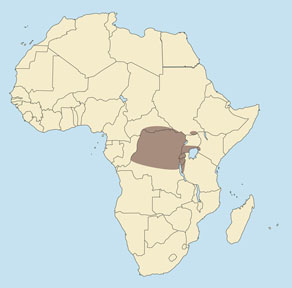 |
Cephalophus weynsi
Duiquer de Weyns (Sp), Weynsducker (G), Céphalophe de Weyns (F).
DESCRIPTION Shoulder height about 22 inches (56 cm). Weight 35-45 pounds (16-20 kg).
A medium-large, plain-looking duiker, with a long, narrow muzzle, and a soft, fine coat. The hair on the nape of the neck is directed forward. The general color is a dull brown or reddish brown, with no belly stripe or facial blaze. Normally there is no dorsal stripe; however, specimens from south of the Congo River in Congo (K) sometimes do have a dorsal stripe. The short head tuft is reddish with no black in it, the forehead is reddish black, the cheeks are pale brown above and whitish below, and the muzzle is chocolate brown. The short, round ears are brown with whitish edges. (A darker race, lestradei, is found in Rwanda. It is dark grayish brown with some red, and has a broad dorsal stripe from shoulders to root of tail.) The horns (both sexes) are cone-shaped and heavily ringed and thick at the base. Females are similar to males, but have smaller horns.
BEHAVIOR Believed to be diurnal. These animals are poorly known.
HABITAT Equatorial forest and mountain forest
DISTRIBUTION Southeastern Central African Republic near the lower Mbari River; northern and central Congo (K); possibly in the Yambio area of southwestern Sudan; the Imatong Mountains of southeastern Sudan; southern Uganda; western Kenya; southwestern Rwanda; western Burundi; and extreme western Tanzania.
Some authorities feel the Mbari River specimens are either bay duikers, Peters duikers or Gabon duikers; however, those taken to date lack the distinctive markings of any of these species. We believe the animals in question are Weyns duikers.
TAXONOMIC NOTES At various times the Weyns duiker has been regarded as a subspecies of Peters duiker (Cephalophus callipygus), of Harvey red duiker (C. harveyi), or of Natal red duiker (C. natalensis); however, we have elected to follow Groves & Grubb in treating it as a full species (C. weynsi). The following subspecies have been listed: barbertoni (Mt. Elgon to Kakamega Forest in Kenya), ignifer (westward in Kenya from Mt. Kenya), johnstoni (east of Ruwenzori in Uganda), lestradi (Rwanda), rutshuricus (Congo [K]-Uganda border), and weynsi (northern Congo [K], east of the Congo and Ubangi rivers).
|





